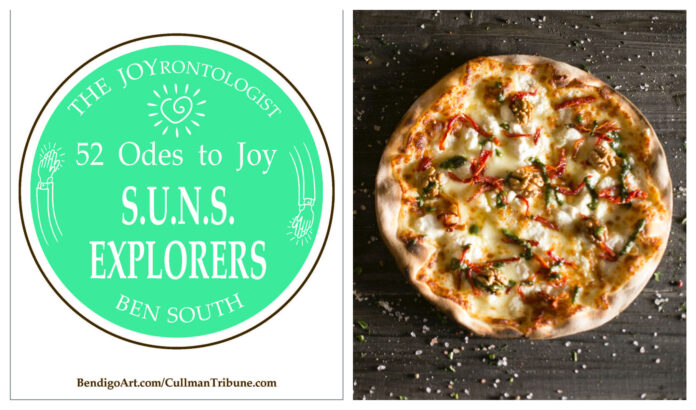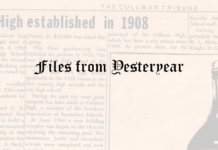“The JOYrontologist” is saluting joy-seeking explorers this Columbus Day holiday. As we raise flutes of Prosecco and chow down on veal pizza (recipe below), I’m thinking not only of the great, Italian navigator, Cristoforo Columbo, and his Spanish “GoFundMe” campaigns but also of the many and diverse, bold, determined explorers who have led searches for the “Fountains of Youthful Aging.”
S.U.N.S. EXPLORERS is an honorific I’m applying to those gerontologists, psychologists and pop culture “joy adventurers” I’ve studied to provide a foundation for “The S.U.N.S. (Smile-Making, Uniting, Neighboring, Spellbinding) Joyous Aging System.”
“The Fountain of Youth” is a mythical spring alleged to restore the youthful happiness and contentment of anyone who drinks or bathes in its waters. Talk of such a font has been explored around the globe for thousands of years and appeared in the writings of the Greek historian, Herodotus, 500 years before the birth of Jesus of Nazareth.
The most prominent of the explorers for the “Fountain of Youth,” was Ponce de Leon, the first governor of Puerto Rico, a sort of 16th century gerontology researcher. He traveled to Florida on his search for a youth-restoring tonic popularly promising to reverse the aging process. Think of Estee’ Lauder “Youth Dew” working from the inside out. Forget about Palm Beach; legend has it, the Native Floridians told the Spanish explorer that the “Fountain of Youth” was at Bimini in The Bahamas.
S.U.N.S. EXPLORERS that I’ve found inspiring include these 10, among many:
1) ABRAHAM MASLOW, an American psychologist, explored the importance of focusing on the positive aspects of people, instead of treating them as a “bag of symptoms.” He is best known for creating a theory that psychological health is based on fulfilling innate human needs in a stair-stepping priority, these peaking with self-actualization. “Maslow’s Hierarchy of Needs” ascends from physical necessities to safety, love/belong, esteem/achievement and ultimately to morality/creativity—self-actualization.
S.U.N.S. EXPLORER, Dr. Maslow stated:
“You will either step forward into growth, or you will step back into safety. Make the growth choice a dozen times a day.”
“The most fortunate are those who have a wonderful capacity to appreciate again and again, freshly and naively, the basic goods of life, with awe, pleasure, wonder and even ecstasy.”
“You must want to be first-class…meaning the best. If you plan on being anything less than you are capable of being, you will probably be unhappy all the days of your life.”
“A musician must make music, an artist must paint, a poet must write, if he is to be ultimately at peace with himself. What a person can be, they must be.”
“Be independent of the good opinion of other people.”
2) THE RED HAT SOCIETY explores how women 50+ can add more smiles, joy and laughter to their lives. (Note: This may be the first roster of “joy champions” which has Dr. Maslow immediately linked to The Red Hat Society.) Internationally, there are more than 25,000 Red Had Society members.
The far-from-shrinking violets wear purple outfits, red hats and layer on more attention-getting accessories like feather boas and LED jewelry. The Red Hatters host tea parties, play games, raise hell in taverns, go to lively entertainments and clamor to hoot and holler at their annual, circus-y RHS conventions.
California artist Sue Ellen Cooper accidentally launched this exploration of “50+ joy” when she bought a red hat on a trip to Tucson, and then another which she gave as a birthday gift to joyously aging friend. Accompanying the red hat gift, the S.U.N.S. EXPLORER included the poem, “Warning,” by British poet, Jenny Joseph:
WARNING
When I am an old woman, I shall wear purple
With a red hat which doesn’t go and doesn’t suit me.
And I shall spend my pension on brandy and summer gloves
And satin sandals and say we have no money for butter.
I shall sit down on the pavement when I’m tired
And gobble up samples in shops and press alarm bells
And run my stick along the public railings
And make up for the sobriety of my youth.
I shall go out in my slippers in the rain
And pick the flowers in other people’s garden
And learn to spit.
You can wear terrible skirts and grow more fat
And eat three pounds of sausages at a go
Or only bread and pickles for a week
And hoard pens and pencils and beermats and things in boxes.
But now we must have clothes that keep us dry
And pay our rent and not swear in the street
And set a good example for the children.
We must have friends to dinner and read the papers,
But maybe I ought to practice a little now?
So people who know me are not too shocked and surprised
When suddenly I’m old, and start to wear purple.
3) DR. CAROL RYFF, an academic professor and researcher (University of Wisconsin-Madison) is one of the most influential explorers in the field of “positive psychology.” Dr. Ryff is a popular and engaging speaker with many talks and interviews available to you on YouTube.
She is most known for “The Six-Factor Model of Psychological Well-Being” which names these as essentials: self-acceptance, personal growth, purpose in life, environmental mastery, autonomy and positive relations with others.
Ryff has stated, “There is a science emerging that an optimistic outlook isn’t just a state of mind. It also has linkages to what’s going on in the brain and in the body.”
“Power of a Super Attitude,” an article by Sharon Jayson in USA Today (October 2004) reports, “Ryff has shown that individuals of well-being have lower cardiovascular risk, lower levels of stress hormones and lower levels of inflammation which serves as a marker of the immune system.”
4) DOM PIERRE PERIGNON, a French, Benedictine monk, created champagne on Aug. 4, 1693. While exploring fermentation processes in the abbey wine cellar, he is said to have yelled joyously to his monastic brothers, “Come quickly! I am drinking the stars!” At least that is how this fantastic story goes and if it is not truth, I don’t want to explore it.
5) JAZZ MUSICIANS originated the joyous sound by exploring a combination of “Swing,” “Blues” and “Ragtime” traditions. Talented, often unschooled, music makers from various neighborhoods of New Orleans in the late 19th and early 20th centuries blended complex chords, call and response vocals with improvisation to create the joyous pleasure of this worldwide musical genre.
6) VIKTOR FRANKL explored “one’s search for life’s meaning” as the central, positive motivating factor in humanistic psychology. The Austrian psychiatrist was a Holocaust survivor and author of the autobiographical best-seller, “Man’s Search for Meaning,” based on his experience enduring and triumphing beyond imprisonment in various Nazi concentration camps.
S.U.N.S. EXPLORER inspiration from Viktor Frankl, include these insights:
“Life is not primarily a quest for pleasure, as Freud believed, or a quest for power, as Alfred Adler taught, but a quest for meaning. The greatest task for any person is to find meaning in his or her own life.”
“When we are no longer able to change a situation—we are challenged to change ourselves.”
“When a person can’t find a deep sense of meaning, they distract themselves with pleasure.”
“Success, like happiness, is the unexpected side effect of one’s personal dedication to a cause greater than oneself.”
“Everything can be taken from a person but one thing; the last of human freedoms—to choose one’s attitude in any given set of circumstances, to choose one’s own way.”
“Even when it is not attained, we become better by striving for a higher goal.”
“The attempt to develop a sense of humor and to see things in a humorous light is a useful trick learned while mastering the art of living.”
“The meaning of my life is to help others find meaning in theirs.”
7) DR. MARTIN SELIGMAN, the most high-profile explorer of “positive psychology,” defines his work as the “scientific study of positive human functioning and flourishing on multiple levels that include biological, personal, relational, institutional, cultural, and global dimensions of life.”
Eudamonia, a Greek word meaning “good spirit” is at the heart of positive psychology and cherishing those things which contribute most to having a good life. Dr. Seligman refers to “the good life” as using your signature strengths to produce “happiness and abundant gratification.”
Positive psychology as a term was used as early as 1954 when Abraham Maslow (see above) titled the final chapter of his milestone book, “Motivation and Personality”—“Toward a Positive Psychology.”
However, it was in 1998, when Martin Seligman, chose “positive psychology” as the theme for his term as president of the American Psychological Association that the professional community prioritized the exploration. Prior to the late 20th century, psychology had been consumed with the negativities of mental illness and what Seligman calls “learned helplessness.”
Seligman considers the following to be essentials for well-being: positive emotion, engagement (the presence of the “flow state”), relationships, meaning and achievement. Here are only two thoughts from this highly quotable and positively impactful joy-giver:
“Optimism generates hope…hope releases dreams…dreams set goals…enthusiasm follows.”
“Doing a kindness produces the single most reliable momentary increase in well-being of any exercise we have tested.”
8) MODERN DAY, NATIVE AMERICAN POWWOWS are time-weaving, joyous, sensory explorations of colorful dancing, drumming, singing, tactile pleasures of crafts such as leatherwork and weaving, savored with the smells and tastes of tribal culinary traditions.
The contemporary powwow gathering is often inter-tribal and one of the most culturally relevant events for Native Americans today. Powwows are highly anticipated, festive celebrations of positive identity and ethnic pride.
9) DR. MIHALY ROBERT CSIKSZENTMIHALYI was a Hungarian American psychologist who, in the 1970s, began exploring the positively SPELLBINDING experience of one being “in the flow.” He defined “flow” as an intense concentration, loss of self-awareness, being perfectly challenged (neither bored nor overwhelmed) when one has the sense that “time is flying.”
Whether one’s particular “flow” is playing lawn tennis or mowing a lawn, Dr. C shared these thoughts from his explorations:
“A joyful life is an individual creation that cannot be copied from a recipe.”
“The best moments in lives, are not the passive, receptive, relaxing times—although such experiences can be enjoyable if we have worked hard to attain them. The best moments usually occur when a person’s body or mind is stretched to its limits in a voluntary effort to accomplish something difficult and worthwhile.”
“The task is to learn how to enjoy everyday life without diminishing other people’s chances to enjoy theirs.”
10) DR. ALAN D. CASTEL is the author of “Better With Age: The Psychology of Successful Aging” which I dedicated an entire chapter of this “52 ODES TO JOY” series to a month ago. Especially for the 50+ crowd, Dr. Castel is an illuminating S.U.N.S. EXPLORER.
S.U.N.S. EXPLORER INSPIRATION from CHRISTOPHER COLUMBUS
“One does not discover new lands without consenting to lose sight of the shore for a very long time.”
“By prevailing over all obstacles and distractions, one may unfailingly arrive at their chosen goal or destination.”
“Life has more imagination than we carry in our dreams.”
“Riches don’t make someone rich they only make them busier.”
LAFFS FOR COLUMBUS DAY
Happy Columbus Day! I’m celebrating by getting lost in the grocery store looking for the spice aisle.
Christopher Columbus got lost because the mapping directions on his phone weren’t pacific.
My Native American relatives want to say “Thank You” this Columbus Day. Actually, they want to walk into somebody’s nice place and say, “Thank you, we live here now.”
JOY-GIVERS CELEBRATING A BIRTHDAY THIS WEEK
Oct. 8—CeCe Winans
Oct. 9—Jackson Browne
Oct. 10—Helen Hayes
Oct. 11—Cardi B
Oct. 12—Dick Gregory
Oct. 13—Lenny Bruce
Oct. 14—Ralph Lauren
COLUMBUS DAY VEAL PIZZA—OKLAHOMA VEAL
(Source: nowyourecookingrecipes.com)
Each week, “The JOYrontologist” shares a recipe saluting a healthy food produced in America. This nutritious and delicious collection is called “The S.U.N.S. Longevity Cookbook” and highlights vitamin B-3 (niacin) which many gerontologists believe holds the promise of a long, healthy, joyful life.
INGREDIENTS
- 1/2 lb. ground veal
- 2 cloves garlic, crushed
- 1 can (7 oz.) tomato sauce
- 1/2 tsp. oregano
- 1/2 tsp. basil
- 1 medium onion
- 1 green or red pepper
- 12-inch baked bread crust
- 1/4 cup grated Parmesan cheese
DIRECTIONS
- In a small frying pan brown the ground veal and garlic. Drain any fat from the pan.
- Add the tomato sauce and seasonings.
- Slice the onion and separate into rounds. Slice pepper into strips. Stir onion and pepper into the veal mixture.
- Spread veal mixture over the crust. Sprinkle Parmesan cheese over the top. Bake at 475F for 10-15 minutes. Makes 3 to 4 servings.
“The JOYrontologist” RECOMMENDS Prosecco and pizza. Beer is frequently the beverage of choice in pizza parlors, but both pizza and beer have galleons (Nina, Pinta and Santa Maria boatloads) of yeast. Consider a sparkling wine from the home country of Christopher Columbus. A good, budget-friendly pairing with pizza is Alberto Nani Organic Prosecco.
1,070 JOY-GIVING THINGS FROM MY FIRST 70 YEARS (continued)
876. Exploring outer space at the U.S. Space and Rocket Center, One Tranquility Base, Huntsville
877. Exploring inner space with Myers-Briggs and Enneagrams
878. Exploring every painting ever conceptualized, drawn or painted by Henri Matisse
879. Exploring pre-Christian Alabama at Moundville
880. Exploring sound in Nashville recording studios
881. Exploring blindness when I worked at the Institute for the Deaf and Blind
882. Exploring fermentation in vineyards and wine cellars
883. Exploring massage and being out of touch with the sense of touch
884. Exploring various configurations of the 26 letters of the alphabet in creative writing classes
885. Exploring the origins of words in one of my favorite classes—Etymology
886. Exploring my familiar town by strolling through it like a flaneuring tourist
887. Exploring the heat of “hot chicken” from Rascal to Ruffian to Rebel to Rogue to Rowdy
888. Exploring American history through the period furniture rooms at the Boston Museum of Art
889. Exploring the commonalities in the prayers of all the old religions
890. Exploring the meaning of life with books by Viktor Frankl and films by Monty Python
HAPPY, SUNNY EXPLORING WEEK!
Read all the installments in this series at www.cullmantribune.com/tag/odes-to-joy-2022.























